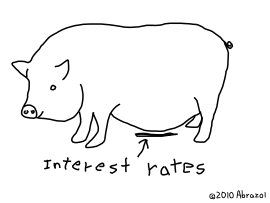With yields on bonds lower than the bottom of a pot bellied pig, stocks that pay a high dividend are becoming as attractive as a nudist colony to a mosquito.

The problem with stocks however is that there is no maturity date on which there is a guaranteed return of principle. In other words the price of a stock can drop by an amount that makes you feel like you just ate a big piece of moldy bread, wiping out any dividend gain and leaving you with a capital loss if you have to sell it.
Happily there are ways to hedge against this possibility. Using options is one way but if the stock is in the S&P 500 (SPX) then a simple hedge is to buy shares of the SH ETF (exchange traded fund). SH is a simple short on the entire SPX, meaning that it goes up when the index goes down and vice versa. If the stock is highly correlated with the index then SH can be used as an efficient hedge.
A list of the stocks in the SPX with dividend yields greater than 4% and their correlations with SPY (an ETF representing the index) and SH can be found here.
An alternative to individual dividend paying stocks is SDY. This is an ETF that represents a large basket of stocks in the SPX that pay reliable dividends. Its yield is currently 3.44%. SDY and SH are almost always very strongly correlated so you can use them as efficient hedges. Currently, SDY and SH are correlated at -0.98 (based on closing price since beginning of 2010 to Oct 22, 2010)
So let's say you've identified two stocks, \(X\) and \(Y\), that you want to use to create a hedged portfolio. They could for example be SDY and SH as discussed above. How many shares of each do you need to buy in order to keep the value of the portfolio constant? Let \(n\) represent the number of shares of \(X\) and \(m\) the number of shares of \(Y\). If \(x_i\) and \(y_i\) are the share prices at time \(i\) then you want the following condition to hold
\[nx_i + my_i = c\]
where \(c\) is a constant. Choose a value of \(m\) and rewrite the equation as:
\[\begin{align}y_i & = \frac{c}{m} - \frac{n}{m}x_i\\& = ax_i + b\end{align}\]
where \(a = -n/m\) and \(b = c/m\). This is a simple linear relationship between the prices of \(X\) and \(Y\) but the problem is that such an exact relationship almost never exists. You can at most fit a line between two points, say \((x_0,y_0)\) and \((x_1,y_1)\) but there is no guarantee that \((x_2,y_2)\) will also be on the line. You cannot satisfy the equation at every point but what you can do is find the values of \(a\) and \(b\) that minimize the error in the least squares sense for a set of historical data points, \((x_i,y_i)\).
For a given data point \((x_i,y_i)\), the deviation between the line and the point will be:
\[E_i = y_i - ax_i - b\]
and what needs to be minimized is the sum of the squares of these errors:
\[E = \sum E_i^2\]
This is a least squares line fitting problem, also called a linear regression problem in statistics. It's not hard to find software that will solve this problem for you. Most spreadsheets have functions for it and some scientific and business calculators can do it for you with a reasonable number of points.
Once \(a\) and \(b\) have been calculated, then for \(m\) shares of \(Y\), the number of shares of \(X\) is
\[n = -ma\]
and the value about which the portfolio should fluctuate is
\[c = mb\]
Note that if \(n\) turns out to be negative, it means that shares of \(X\) would need to be sold short in order to balance out \(Y\). In any case this portfolio hedging will only work if \(X\) and \(Y\) are linearly correlated to some degree.
The same software that solves for \(a\) and \(b\) will usually also give you the linear correlation coefficient for the points. Let \(\rho\) represent the correlation coefficient then the sum of the errors is related to \(\rho\) as follows:
\[E = N\sigma^2_y(1-\rho^2)\]
where \(\sigma^2_y\) is the variance of the \(y_i\) values and \(N\) is the total number of data points. \(\rho\) will range in value from -1 to +1. The closer it is to the ends of the range, the smaller the error. \(X\) and \(Y\) should have a \(\rho\) value with a magnitude of at least 0.5 for the hedge to work well.
Since relationships and correlations in the market change all the time these calculations should also be repeated periodically and the portfolio rebalanced as needed.
© 2010-2012 Stefan Hollos and Richard Hollos
blog comments powered by Disqus